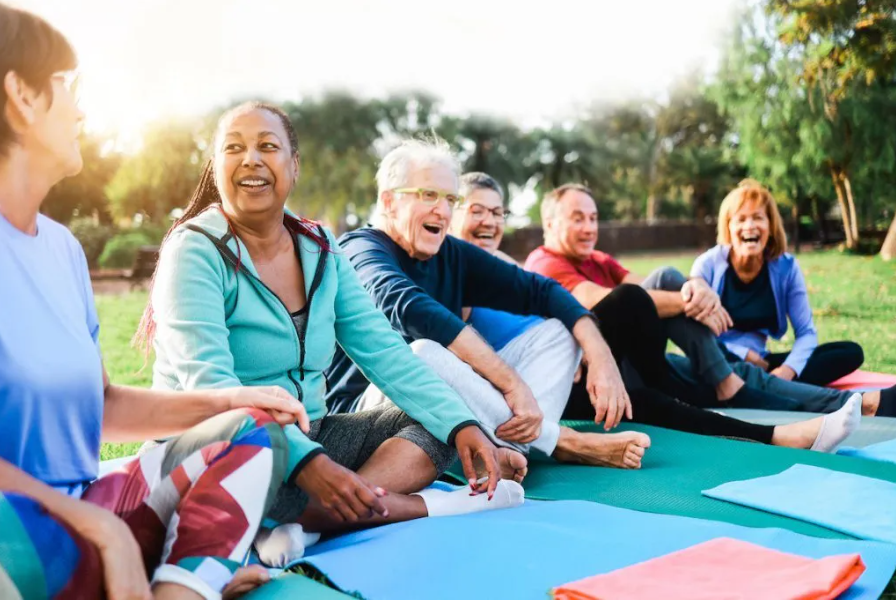Growing old gracefully means taking care of your physical and emotional health. And doing that is way easier than you think it is.

There’s been a lot of talk about the need to reframe the concept of aging. Our golden years shouldn’t be looked at as a time for a quiet and creaky life. In fact, it should be seen as an era of vibrancy and contentment where people can live both longer and healthier.
Healthy aging is a process of maintaining and improving physical and mental health, independence, and quality of life. “People should be able to do what they value throughout their life,” says Delma Montoya-Monge, M.D. She is a geriatrician with UTHealth Houston. What healthy aging may mean to any one person, she adds, can also be defined by their “culture, country, and life experience.”
No one —regardless of their age — is ever completely free of the risk for health problems or disease, says Dr. Montoya-Monge. If you have a chronic condition like diabetes or high blood pressure, aging well means taking the steps to manage it with medication and healthy lifestyle habits. We’ve identified four rules to healthy aging that you should start following today.
Get Regular Check-Ups
As an older adult, you have a higher risk for developing diabetes, osteoporosis, and heart disease. You’re also more likely to require hospitalization if you get an infectious disease like pneumonia, according to the U.S. Department of Health and Human Services.
Because of that, it’s wise to schedule routine visits with your primary care provider to make sure you’re staying healthy. For older adults, depending on age and sex, that may include screening for:
Blood pressure and cholesterol
Breast and colon cancer
Obesity
Alcohol and tobacco use
Aspirin use
Depression
Osteoporosis
You also want to stay current with immunizations, particularly for pneumonia and shingles. Research shows that fewer than half of older adults are up to date on vaccinations and other core preventive health services.
Nurture Your Relationships
Feeling isolated is a big health risk, and a quarter of seniors in the U.S. experience it, according to the Centers for Disease Control (CDC). They also say that loneliness, isolation, and poor connections with others are associated with depression and anxiety, heart disease and stroke, dementia, and premature death.
Some experts believe that loneliness may be just as bad for you as smoking. “I recommend to all my patients that they do the activities that they enjoy.,” says Dr. Montoya-Monge. “If they can do it with a family member or friend, even better.”
If you don’t have loved ones nearby, get involved in activities in your area that matter to you to develop a sense of community.
Maintain A Sense of Purpose
We all want to have a place in this world, and that doesn’t stop when you reach a certain age. “It’s important because many studies have shown that people who have a purpose in life tend to live longer, and it may offer some protection against Alzheimer’s and cardiovascular diseases,” says Dr. Montoya-Monge.
One study found that older adults who had the highest sense of purpose in life had a 24% lower risk of becoming physically inactive, a 33% lower risk of developing sleep problems, and a 22% lower risk of developing an unhealthy BMI compared to seniors who had the lowest sense of it. As Dr. Montoya-Monge points out, you always have something good to offer, whether that’s volunteering, caring for a pet, pursuing a creative hobby, taking classes, or practicing religion.
Stay Active
The secret sauce for aging well physically and mentally is exercise. As the National Council on Aging points out, physical activity improves immunity, slows aging, and maintains cognitive health. What’s more, your body was designed to move.
“Everyday life calls for movement,” says Damien A. Joyner, a San Diego–based A.C.E-certified personal trainer. He’s talking about the things you do regularly, like picking things up off the floor, grabbing a gallon of milk from the fridge, or carrying shopping bags inside from your car.
“Regular exercise that supports — if not mirrors — such actions allows us to age with the ability to do what we need to do and what we enjoy doing,” Joyner explains.
You can stay active in two different ways: regular workouts and moving more throughout the day. Learn how you can incorporate both into your life.
Regular workouts. If you find it difficult to stick to a regular exercise plan, Joyner advises starting small so you can slowly build a habit. “The best exercise routine is one that is the most sustainable for you,” he says.
Try committing to one class a week, then slowly work up to two or three times to reach the 150-minutes a week of moderate-intensity activity that the CDC recommends. (Learn more about creating a balanced weekly workout plan here.)
“What’s inspiring is that when people begin to move more, they feel better and see how they’re moving better in everyday life,” says Joyner. That can be the motivation you need to stick with it.
Move more during the day. You don’t need to be at the gym or take fitness classes to get healthy amounts of exercise. Though you may have heard that 30 minutes a day is the goal, you don’t have to do it all at once. The CDC says it’s perfectly fine to break up your activity into smaller bites — any amount is healthy for you.
So walk to the end of the driveway to pick up your mail, go shopping for groceries instead of having them delivered, or climb up and down the stairs in your home a few more times a day. Or try incorporating micro exercise sessions, or “movement snacks”, into your day.
There are many enjoyable activities that also qualify as exercise, such as gardening, taking a historical walking tour, or dance classes, says Joyner. Having fun and feeling good is exactly what healthy aging should look like.
